SEVEN-YEAR PLAN
FOR THE DEVELOPMENT OF JINR
2017–2023
With amendments approved by the Committee of Plenipotentiaries of the Governments of the JINR Member States at the session held on 25 March 2021 (Seven-year plan for the development of JINR for 2017–2023 in original edition approved by the Committee of Plenipotentiaries of the Governments of the JINR Member States at its session held on 21–22 November 2016)

During the implementation of the current seven-year plan, the execution of the assigned tasks was carried out on the basis of the annually generated Topical Plan for JINR Research and International Cooperation, controlled by internal and external international committees, advisory and governing bodies of the Institute, which took timely decisions on corrective actions when there were circumstances not provided for in the work schedules.
The rapid development of technologies for creating modern physical installations and hardware, increasing demands for competitiveness and attractiveness of new experimental installations for users formed prerequisites for changing the parameters of ongoing projects in order to achieve higher quality of the objects of research infrastructure being put into operation. Risks associated with premature obsolescence of the existing equipment were promptly compensated by planned and unscheduled replacement of the relevant components, determining the addition to the JINR Topical Plan of projects to modernize and expand the capabilities of the existing research infrastructure, as well as a change in the funding profile of some directions.
In November 2020, at a meeting of the Committee of Plenipotentiaries of the JINR Member States, a long-term development strategy of JINR until 2030 and beyond was presented. The available scientific and technical potential of JINR and its visibility at the worldwide scientific arena made it possible to formulate the JINR long-term development strategic plan, declaring the mission of JINR in the context of the globalization of science, the tasks of further increasing the attractiveness of the Institute in response to competition for highly qualified scientific and engineering personnel, as well as approaches to ensuring sustainable development of JINR as an international intergovernmental organization, principles of scientific, organizational and administrative activities, personnel policy and improvement of the social environment.
At the outset of the implementation of the JINR long-term development strategy, objective circumstances arose that motivated the leadership of JINR to conduct a thorough analysis of the fulfillment of the tasks laid down in the seven-year plan. The analysis showed that the pace of actual performance of work on key JINR projects was generally in line with the earlier plans. At the same time, based on the actual and financial performance of the tasks faced by JINR in 2017–2020, in some areas it seems important to bring the content of the seven-year plan in line with the actual deadlines for the work and the available financial resources. Against the background of the intensive development of new scientific directions at JINR, a concomitant task of adjusting the seven-year plan is to consolidate the material and intellectual resources of JINR on the priorities of the current seven-year period.
I am convinced that the measures taken to timely adjust the current seven-year plan will be the key to the successful development of JINR in the coming years and a necessary groundwork for the implementation of the outlined strategic goals.
Grigory Trubnikov
Director of JINR

The present Seven-year plan for the development of the Joint Institute for Nuclear Research for 2017–2023, after intensive preparatory work and discussions for two years at the meetings of the Programme Advisory Committees and the Scientific Council of JINR has eventually been approved by the Committee of Plenipotentiaries of the JINR Member States at its session held in Kraków, Republic of Poland, on 21–22 November 2016.
Taking into account the scope of its ambitious tasks and projects, which assumes the corresponding high level of international cooperation and integration into the global and first of all the European research programmes, I may say that JINR enters into a new era of its development.
JINR is unique for its time-tested trinity of multidisciplinary basic research, international cooperation, and interplay of research and education.
The research programme of JINR includes elementary particle physics, relativistic heavy-ion physics, advanced physics of superheavy elements and exotic neutron-rich nuclei, precision nuclear spectroscopy, neutrino physics and astrophysics, information technologies and computing, fundamental neutron studies, condensed matter physics and new materials, theoretical and mathematical physics, development of modern equipment and experimental techniques, biophysics and radiobiology. Since the establishment of JINR in 1956, scientists from Europe as well as from Asia, Africa and Latin America have been involved in its activities, which has played an important role in determining the scope and versatility of JINR’s science policy.
The rich traditions of the Institute and its highly qualified personnel make it possible to share the knowledge with younger generations of scientists and engineers. This also guarantees the high potential of fundamental physics research as well as applied science and innovative activities. JINR keeps being attractive for young researchers of different nationalities.
The experience of the past years accumulated by JINR and the modern trends of the world science indicate that the strategy of the development of this centre will be aimed at:
- realizing new world-class projects at frontiers of modern physics on the basis of high professional standards and traditions;
- extending international cooperation around the JINR basic facilities, further integration of these facilities into the European and worldwide research infrastructures;
- attracting new countries to the JINR family;
- maintaining the general infrastructure and “modus operandi” of JINR at the best internationally recognized level.
In conclusion, I would like to express my confidence that the future development of JINR in accordance with the goals outlined in the present Seven-year plan will further demonstrate convincingly to the world the attractive force of scientific knowledge and the unprecedented strength of the ties that unite the scientific community despite the diversity of nationalities, religions and races.
RAS Academician Victor Matveev
To substantiate the main goals of the Seven-year plan it is worth having a brief look at the development of modern particle physics, nuclear physics, astrophysics, and condensed matter physics. These areas of research are the core of the JINR scientific programme. Being the most fundamental, they provide the basis and methodology of all science that investigates the structure and properties of matter — from nucleons and nuclei to molecules and condensed matter.

The strategic goal of modern particle physics and astrophysics is the formation of a new unified physical view of the World without “famous problems” of the Standard Model, despite the fact that the latter is an outstanding achievement of humankind. This claim has become very solid after the discovery of the Higgs boson and precise Standard Model descriptions of the numerous data at the electroweak scale of the LHC.
The Standard Model is not the final self-consistent fundamental theory. It can be seen as a low-energy limit of some underlining fundamental theory that would work at a broader energy range up to the Planck scale (1019 GeV). The search for this fundamental theory and its experimental verification is a main trend of modern physics. Another, in a certain sense, opposite trend relates to the fact that QCD has yet to explain the quark confinement and other collective phenomena characteristic for strong interactions at intermediate and large distances. The collective behaviour of hadrons is relevant to a whole hierarchy of basic phenomena ranging from colorless hadron (mesons, baryons, glueballs) formation to nuclear reactions and the physics of nuclei, heavy and superheavy nuclei in particular.
Towards a new theory of elementary particles (a new physical picture of the World), the following sources of information are considered most crucial nowadays:
- Direct search for New Physics at the Large Hadron Collider (supersymmetry, decays of the Higgs boson, extra dimensions, new types of a state of matter, new particles and interactions, etc.);
- Neutrino physics and astrophysics (as the most intriguing and rapidly developing field of modern particle physics);
- Cosmology. Explanation of the nature of Dark Matter and Dark Energy;
- Indirect search for New Physics mainly by means of precision studies of very rare transformations of hadrons and leptons with violation of (flavor) symmetry of generations.
Not being directly connected with New Physics, the Hadron Structure is still a very important and unique source for understanding Quantum Chromodynamics (QCD).
In this regard, the first task of the new phase of LHC experiments is to carry out a comprehensive study of the properties of the Higgs boson for convincing evidence of its Standard Model membership. The second task is to get an answer to the question of the existence (or absence) of New Physics at the TeV scale of energies; a special interest is related to the experimental justification of supersymmetry.
Besides the above tasks, the central problem in particle physics today is the nature of neutrinos i.e. those fundamental properties of neutrinos that determine the specificity of their interactions.
Another fundamental puzzle of Nature is addressing the genesis of the Universe, which concerns today the understanding of inflation, dark matter and dark energy.
One more (indirect) way to search for New Physics is associated with the Physics of Flavor. The goal here is precise study of processes where fermions from one generation are transformed into fermions from another generation (change of flavor). Flavor Physics is currently a robust and crucial tool for the New Physics search, being potentially sensitive to a much higher scale of energy than achievable with future high-energy accelerators.
In general, the main direction of the New Physics search is “routed” today in the “responsibility region” of the (very) weak interactions. However, an essential element of the Standard Model is QCD, a well-developed quantum field theory of strong interactions. In any hadron process at high or low energy (i.e. LHC or beta decay), QCD is a main source of the formation of particles and inevitable background for the New Physics search. A detailed understanding of QCD effects is strongly requested for a correct interpretation of the experimental data.
Perturbative QCD mainly due to the asymptotic freedom is an effective and well-working theoretical method which describes quark-gluon interactions at large momentum transfers (hard processes). However, Nonperturbative QCD, with its effect of confinement, inevitably presents everywhere at high energy in the form of parton distributions, fragmentation functions and other soft interactions of hadrons.
Nonperturbative QCD is, in fact, an important part of the Standard Model intended to explain from the first principles the dynamical chiral symmetry breaking (which generates about 98% of the visible mass in the Universe), the confinement, and the Entire Nuclear Physics — how hadrons are made from quarks and gluons and how they are producing all the diversity of atomic nuclei, interacting with each other.
These problems are very general and extremely complex, and to solve them one needs extra experimental information related to the search of new physics signatures in laboratory experiments and astrophysical observations as well as from the study of hadron matter properties in collider experiments and in compact stars. In addition to soft nonperturbative QCD processes (e.g. at the LHC), the main hopes for resolution of the long-standing problems of strong interaction physics are connected with the study of heavy-ion collisions at high energy, where the conditions are created for phase transformations in hot and dense hadronic matter.
Step-by-step addressing of the above fundamental issues requires studying a whole set of basic problems that are in the focus of the JINR Seven-year plan.
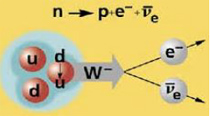 Neutron beta decay is a key process for precision test of the Standard Model. It is very sensitive to various extensions of the sector of charged weak currents, etc. Ultracold neutron physics is also very important basic research.
Neutron beta decay is a key process for precision test of the Standard Model. It is very sensitive to various extensions of the sector of charged weak currents, etc. Ultracold neutron physics is also very important basic research.
High-precision measurements of neutron beta decay (lifetime, angular correlations) are very important for determining the key elements of the Cabibbo-Kobayashi-Maskawa matrix and for understanding neutron structure in QCD. The properties of the neutron and neutron-induced nuclear reactions are very important for the study of many astrophysical processes. In particular, cross-sections for neutron capture reactions are crucial for understanding isotope formations in stars, supernovae, etc.- Any information about stable enough and unusual hadron states — glueballs, hypernucleus, light nuclei with large neutron excess, double(tetra)-baryons and other cluster configurations in nuclei — is crucial for understanding the QCD phenomena beyond perturbation theory.
This important information can be obtained via study of nuclear reactions induced by stable and radioactive ion beams of (exotic) light atomic elements. - Heavy-ion physics is a most rapidly developing area of nuclear physics at low and intermediate energy. Major achievements are the synthesis and study of nuclear, chemical and physical properties of transfermium (Z > 100) and superheavy elements (SHE), the formation and study of the properties of light exotic nuclei, study of reaction mechanisms with accelerated ions of stable and radioactive isotopes, etc.
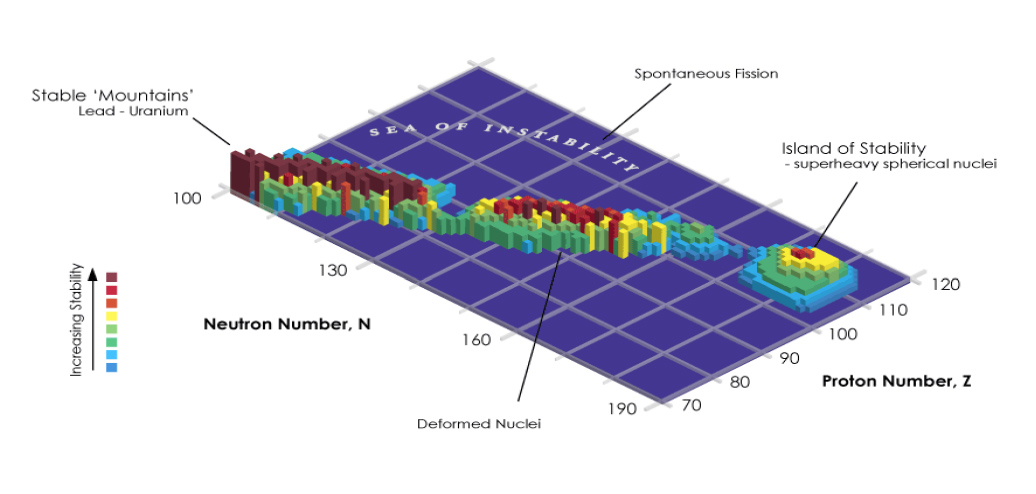
The prediction of the “island of stability” of SHE is a fundamental achievement of the macro- microscopic nuclear theory. Formation of SHE is a very rare event (pb). Moreover, the position and properties of the island is strongly dependent on a particular nuclear model. To specify the nuclear models it is necessary to study SHE with Z = 113–118 and to create new isotopes with Z = 119, 120. New data are needed about nuclear levels; data on fusion-fission at low excitation is important for determining the lifetimes of nuclei and optimization of their synthesis, etc. - Study of the various characteristics of spontaneous and neutron-induced fission is of primary interest, particularly due to the availability of modern high-intensity neutron sources and due to the fact that nuclear fission is one of the most complex nuclear transformations associated with a profound redistribution of mass and charge of the original nuclei, producing highly deformed and excited fragments, etc.
All these nuclear physics studies improve the nuclear models (and understanding of nuclear structure) with a final goal to connect the models with basic concept of nonperturbative QCD.
In accordance with the main directions of development of modern particle physics and astrophysics these are the following major goals of JINR’s new Seven-year plan:
- Direct search for New Physics with the LHC: the main goal is to get fundamentally important results concerning the nature of the Higgs boson, the existence or non-existence of TeV- scale supersymmetry, extra dimensions of space and new interactions, the nucleon structure and properties of quark-gluon QCD matter, etc. — by means of full-scale participation in the international multi-purpose experiments ATLAS and CMS at 13–14 TeV.
- Neutrino programme: research on neutrino astrophysics with unique Baikal-GVD neutrino telescope, basic and applied research with antineutrino beams of the Kalinin nuclear power plant, participation, due to the decisive contributions of JINR, in major international experiments (JUNO, SuperNEMO, NOvA, EURICA, DS, etc.), and establishment of JINR’s corresponding research infrastructure at the most advanced level.
- in the Flavor sector: the main goal is to continue traditional research at JINR on the flavor physics of quarks and charged leptons by participating in the world’s most important international experiments on the study of rare CP-violating kaon decays (like for example, K→ πνν) and search for muon to electron conversion on nuclei (Mu2e and COMET).
- in Perturbative and nonperturbative QCD studies: the goals are (a) to participate in major international experiments on nucleon and nuclear structure research (COMPASS, BESIII, PANDA, etc.) with the aim to obtain decisive information for a better understanding of QCD properties, hadron spin structure, etc.; (b) to continue basic research on neutron physics with IBR-2; (c) within an international collaboration on external sources of ultracold neutrons, to measure the key parameters of the neutron — beta decay, electric dipole moment, etc.
- in Relativistic physics of atomic nuclei (heavy ions): The experimental long-term task of JINR’s megascience project NICA is investigation of hot and dense strongly interacting QCD-matter, search for a mixed phase and critical point in the QCD phase diagram with the main goal to shed light on the poorly explored region of this diagram and clarify the basis of QCD in the nonperturbative regime and other theoretical approaches for the description of strongly interacting matter. To this end, in the nearest seven years, JINR should put the NICA complex into operation, complete the installation of the BM@N and MPD detectors, and reach their design parameters to obtain new results in understanding hot-dense baryonic matter and its phase transitions. The NICA energy is believed to be particularly interesting because it corresponds to maximal net baryon density at the time of “freezing”. At this energy, the system takes the maximum amount of space-time in the form of a mixed phase of quark-hadron matter (coexistence of hadron and quark-gluon phases).
- in Modern nuclear physics (due to interconnection with QCD and particle physics): the main goal is to enhance JINR’s leadership in the physics of superheavy elements through a qualitatively new-level research at the JINR Factory of SHE on the synthesis and study of nuclear, physical and chemical properties of SHE isotopes, on the study of reaction mechanisms with stable and radioactive nuclei, on the search for new types of atomic nuclei decay, etc.
The final, most fundamental aim of this very important nuclear physics study is the connection with QCD basic principles. - in Condensed matter physics: the main goal is the development of experimental facilities in order to utilize efficiently the possibilities of the IBR-2 pulsed reactor — one of the three most intense neutron sources in the world. Studying the physics and chemistry of complex fluids and polymers, functional materials, novel physics of nanosystems brings new technological applications in power engineering, electronics, biology, medicine, etc. Since the planned lifetime of the IBR-2 reactor is limited to the middle 2030s, then within the framework of the new seven-year plan it is necessary to develop a concept and preliminary design of a new world-class facility for research with beams neutrons, and also begin the work on development of a fuel load for the new source. Also, as part of the current seven-year plan, activity will be started on modeling experimental infrastructure of the new source, including elements experimental installations with prototyping of individual components at the IBR-2.
- in Information Technology, the main goal is to carry out fundamental promising and advanced research in the field of distributed computing, computational mathematics and computational physics aimed at the creation and use of new computing platforms, the development of new mathematical methods, algorithms and software by addressing urgent problems arising in experimental and theoretical studies. The solution of this task is closely related to a wide range of research conducted at JINR in high-energy physics, nuclear physics, condensed matter physics and nanotechnology as well as radiobiology and biophysics, and several other areas that require application and development of new approaches to modeling physical processes, processing and analysis of experimental data, including application in the studies within the NICA project, in the neutrino programme and in other strategic goals of the Institute. Within the modern computerized world, the advancement of the development in this direction is fundamental for the progress in all the other areas of the JINR research.

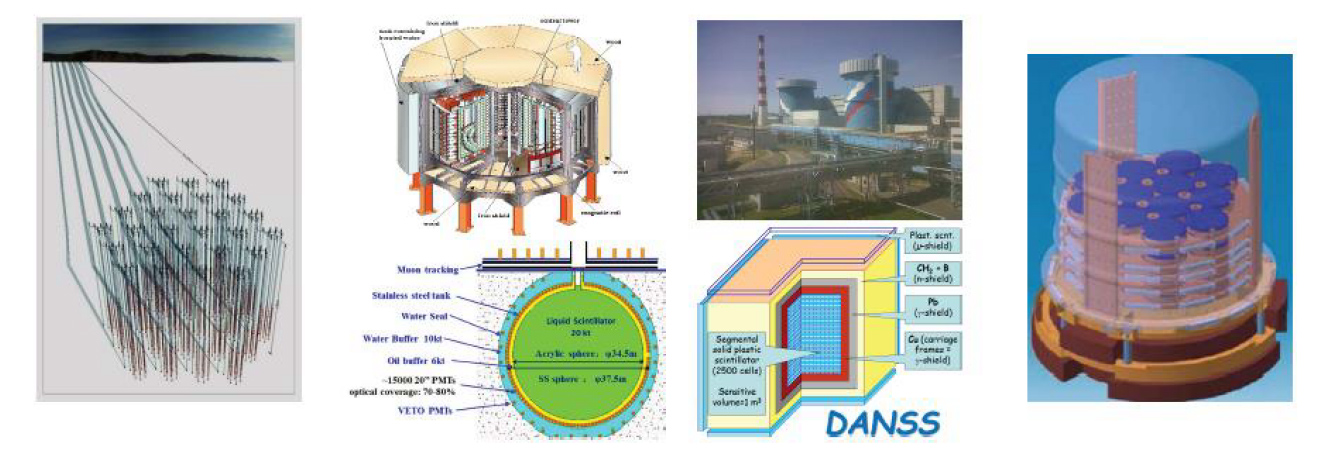




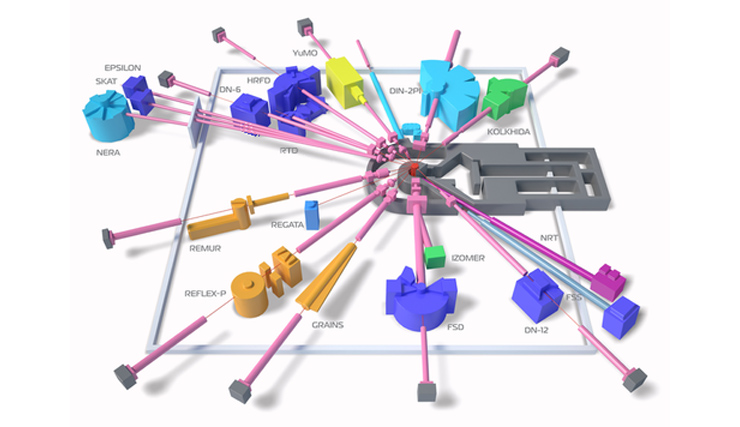 Spectrometer complex of the IBR-2 facility
Spectrometer complex of the IBR-2 facility

Development of the JINR facilities
The main aim of the NICA project is construction of an accelerator complex allowing to conduct research with colliding beams of high-intensity ions (up to Au+79) with the average luminosity L=1027cm-2s-1 at an energy range of √sNN = 4–11 GeV, also with beams of polarized protons (√sNN up to 26 GeV) and deuterons (√sNN up to 12 GeV) with longitudinal and transverse polarization as well as with extracted beams of ions and polarized protons and deuterons.
For effective use of the NICA complex opportunities, dedicated experimental set-ups will be built and put into operation: BM@N for the extracted beams, and MPD and SPD for the collider.
The following are the stages of construction, commissioning and development of elements of the NICA complex:
- Commissioning of the NICA basic elements (in accordance with the schedule: booster — 2020; basic configuration of the collider — 2022–2023; design configuration of the collider — 2025). Development of experimental zones and extracted beam channels of the NICA complex — 2022.
- Creation and start-up of an infrastructure for carrying out research in the field of hadron radiation therapy and other applied research in the fields of radiobiology and radiation-resistant microelectronics based on the VBLHEP accelerator complex — 2017–2023.
- The start-up of the BM@N initial configuration for high-intensity light-ion beams extracted from the Nuclotron — 2017.
- Completion of the upgrade and commissioning of the BM@N set-up for high-intensity heavy-ion beams extracted from the Nuclotron — 2021.
- Start-up of the MPD Stage I — 2022.
- Commissioning of the MPD Stage II — 2025.
- Putting into operation of the initial configuration of the SPD detector — 2025.
Full-scale realization of the project DRIBs-III (Dubna Radioactive Ion Beams), as a major part – the start-up of the Factory of Superheavy Elements (SHE Factory) based on a specialized cyclotron, DC-280, together with experimental instruments of a new generation is the major task of the Flerov Laboratory of Nuclear Reactions for the period 2017–2023. This will considerably expand the possibilities for carrying out fundamental and applied research in nuclear physics at JINR at the highest level in broad cooperation with scientific centres of the Member States and other countries.
IBR-2 is a JINR’s basic facility for neutron studies of condensed matter, one of the most powerful pulsed neutron sources in the world and the only one in the JINR Member States. Under the previous Seven-year plan, the first cryogenic moderators were constructed; the number of the reactor spectrometers for condensed matter investigations increased from 11 to 14, and significant upgrades of the number of available spectrometers were carried out.
SOLCRYS Structural Research Laboratory
Condensed matter research at JINR is carried out in the field of studying new materials (catalysts, polymers, etc.), nanomaterials (nanoparticles, nanocomposites, etc.), materials under extreme conditions (superconductors, perovskites, etc.) and biomaterials (proteins, DNA, etc.). Research methods based on scattering of synchrotron radiation will be developed on the basis of the National Synchrotron Radiation Center SOLARIS of the Jagiellonian University in Krakow (Poland), where JINR proposes to create a new Laboratory for Structural Research SOLCRYS. It is planned to create three measuring stations:
- for macromolecular X-ray crystallography;
- for small-angle X-ray scattering;
- for powder diffraction.
JINR’s traditional research activities in the field of nuclear physics with neutrons will be carried out at a high-resolution neutron source — IREN facility.
Further development of the IREN facility in 2017–2023 is connected with the improvement of the accelerator’s systems and with the modernization of the infrastructure of the experimental hall and pavilions.
The Gigaton Volume Detector (BAIKAL-GVD) Facility in Lake Baikal is an extension of the R&D work on the first phase performed over the past several years by the BAIKAL Collaboration. The optical properties of the deep-water lake have been established, and the detection of high-energy neutrinos has been demonstrated with the existing detector NT200/NT200+. This achievement represents a proof of the concept for commissioning a new instrument, BAIKAL-GVD, with superior detector performance and an effective telescope size at or above the kilometer-scale.
Within the framework of the current seven-year plan, JINR’s obligations regarding the creation of the BAIKAL-GVD neutrino telescope are to commission 12 clusters and complete the first stage of the detector construction. The years 2022–2023 will be used to study the possibility of technological modernization of the BAIKAL-GVD unit in preparation for the next stage of development.
The second-stage neutrino telescope BAIKAL-GVD will be a new research infrastructure aimed primarily at studying astrophysical neutrino fluxes. The detector will utilize Lake Baikal water instrumented at depth with optical sensors that detect the Cherenkov radiation from secondary particles produced in interactions of high-energy neutrinos inside or near the instrumented volume. The concept of BAIKAL-GVD is based on a number of evident requirements to the design and architecture of the recording system of the new array: the utmost use of the advantages of array deployment from the ice cover of Lake Baikal, the extendibility of the facility and provision of its effective operation even in the first stage of deployment, and the possibility of implementing different versions of arrangement and spatial distribution of light sensors within the same measuring system.

Particle Physics and High-Energy Heavy-Ion Physics
Scientific research in the field of elementary particle physics and high-energy heavy-ion physics can be classified into four interrelated directions — the energy-increasing accelerator direction (the Energy Frontier), the intensity-increasing accelerator direction (the Intensity Frontier), the accuracy-increasing non-accelerator direction (the Accuracy Frontier), and the particle astrophysics direction (the Cosmic Frontier). In view of these general directions, within the framework of the new Seven-year plan, JINR will focus on the following main topics:
- Particle physics research, including particle spectroscopy, spin physics, neutrino physics and rare phenomena studies (covering the Energy, Intensity, Accuracy, and Cosmic Frontiers), aimed at extending the Standard Model and discovering new fundamental laws of Nature.
- High-energy heavy-ion physics research (Energy and Intensity Frontiers) aimed at establishing unique properties of hadronic matter under conditions of phase transitions between quark and hadronic states of matter.
- Development of new-generation detector systems and accelerator complexes, theoretical support of the current and planned experimental investigations, development and maintenance of high-performance telecommunication links and computing facilities at JINR, aimed at providing a comprehensive support for realization of the scientific tasks envisioned by the seven-year plan.
The new Seven-year plan in the field of particle and high-energy heavy-ion physics will be implemented by efforts of four JINR Laboratories (VBLHEP, DLNP, LIT, and BLTP) both on the JINR in-house facility base — the NICA accelerator complex, and within the framework of international partnership programmes at the world’s largest accelerator facilities in the experiments with essential contribution made by JINR staff.
JINR will continue to participate in the development of accelerator subsystems and detectors within the ILC project.
Within the framework of the FLASH and XFEL international projects, JINR physicists participate in the development of diagnostic systems of ultrashort bunches in the linear accelerator, X-ray, large cryogenic systems.
The study of hot and dense baryonic matter and its phase transformations will be performed at the NICA complex, whose basic configuration is planned to be carried out in the second half of the seven-year period. Experiments will be carried out with extracted beams of the Nuclotron at the BM@N set-up and in the collider mode at MPD in heavy-ion collisions at the energy range √sNN = 4–11 GeV. The launching of the NICA complex and the mentioned detectors, their final adjusting to the design objectives, and obtaining new experimental results will be the primary tasks for VBLHEP in the next seven years.
The VBLHEP research groups will continue taking part in the study of nuclear matter properties under extreme conditions, in the search for the onset of quark deconfinement and possible phase transitions within common research programmes in the STAR experiment at RHIC, BNL, in the NA6I experiment at CERN’s SPS, in the ALICE experiment at CERN’s LHC, and in the CBM experiment at FAIR, GSI. The scope of JINR’s participation will be assessed and possibly limited depending on the progress in implementing the NICA project as well as on the necessity to consolidate work at the JINR accelerator complex.
The study of nucleon spin structure and other polarization phenomena in nucleon–nucleon and nucleon-nuclei interactions as well as in few-nucleon systems will be carried out at the VBLHEP accelerator complex and at CERN and BNL. Both fixed-target experiments with Nuclotron polarized beams and NICA collider experiments at the SPD detector will be performed at VBLHEP. Construction of SPD is planned to be implemented within the next Seven-year plan according to the technical design project which is to be prepared. The SPD research programme will extend the ongoing programme of hadron structure and spectroscopy investigations with high-intensity muon and hadron beams in the COMPASS experiment (CERN’s SPS) as well as with polarized proton beams at STAR (BNL), in which JINR will continue its participation during 2017–2023.
The search for physical phenomena beyond the Standard Model will be continued in the CMS and ATLAS experiments at CERN’s LHC.
JINR will take part in the upgrade of detectors during LHC shut-down periods in 2018–2019 and 2022–2024 and will continue the analysis of data from the LHC.
The JINR group is supposed to take part in a search for weakly interacting particles of dark matter which is proposed to be conducted at CERN’s SPS. JINR will also participate in a search for charged lepton flavour violation in muon-to-electron conversion in the μ2e (FNAL) and COMET (J-PARC) experiments.
The JINR team will continue a series of precise experiments to study kaon decays, including those with direct CP violation, in the NA62 experiment at CERN’s SPS.
In the field of accelerator physics and technology, in addition to work on the construction of elements for the NICA accelerator facility and participation in the preparation of ILC systems, collaborative effort on the construction of the FAIR complex is planned under the Russia-FAIR and JINR-FAIR programmes.
Neutrino physics and astrophysics offer promising possibilities to study the fundamental, key issues of modern elementary particle physics. Observation of neutrino oscillations, which led to the 2015 Nobel Prize in Physics, requires neutrinos to have non-zero mass as well as lepton number non-conservation.
DLNP is taking part in the leading experiments studying neutrino oscillations such as the Daya Bay reactor neutrino experiment, which discovered a non-zero value of the mixing angle Ѳ13 — a result garnering the 2016 Breakthrough Prize in Fundamental Physics.
The mass hierarchy problem will be addressed by JINR scientists with the help of two complementary techniques using reactor and accelerator neutrinos in the JUNO and NOvA experiments respectively.
CP violation in the lepton sector will be addressed with help of another accelerator experiment — DUNE, in which JINR plans to enhance its participation.
The study of double-beta decay processes is also of high priority at DLNP and is conducted within the framework of the GERDA-MAJORANA (G&M) and SuperNEMO projects.
DLNP will continue to participate in the study of solar neutrinos in the BOREXINO experiment.
DLNP plans an increasing international large-scale participation in the BAIKAL-GVD experiment focusing on the detection of ultrahigh-energy cosmic neutrinos. A continuous increase of the observable volume up to 0.4 km3 in parallel with data taking is foreseen during 2017–2023.
During 2017–2020, JINR aims to complete its major contribution to the construction of the JUNO experiment.
JINR plays a leading role in advanced reactor neutrino experiments in the immediate vicinity of nuclear reactors (DANSS, GEMMA / νGeN). The development of experimental techniques, synergy with other low-background projects of JINR, allows and will allow in the future to carry out new research at the forefront of science.

Nuclear Physics
The following main areas of research in the field of low-energy nuclear physics will be further developed in 2017–2023: synthesis of superheavy elements using heavy ions and study of their physical and chemical properties, basic research with neutrons, and applied investigations.
The unique opportunities of JINR’s heavy-ion accelerators and experimental research instruments have led to the establishment of broad international collaborations with research centres of the JINR Member States and other countries.
- Synthesis of superheavy elements and study of their nuclear properties
- Investigation of incomplete fusion reactions of massive nuclei
- Synthesis of new nuclides in the heavy nuclei region and study of their properties
- Nuclear structure of elements of the “second hundred”
- Study of mechanisms of reactions with stable and radioactive nuclei, search for new decay modes
- Nuclear physics with neutrons:
- Investigations of the violation of fundamental symmetries in neutron-nuclear interactions and related data
- Investigations of fundamental properties of the neutron and UCN physics
- Applied and methodological research

Condensed Matter Physics
JINR has a unique base for experimental research (the IBR-2 pulse reactor and the DRIBs-III accelerator complex) allowing its scientists to conduct basic and applied research in the field of the physics of condensed state of matter and in adjacent areas — biology, medicine, materials science, etc., aimed at studying the structure and properties of nanosystems and new materials, biological objects, and biotechnologies.
- Neutron scattering research methods
- Optical methods of research
- Applied research with heavy ions
Radiobiological and astrobiological research:
- Research on the mechanisms of the induction of molecular disorders of the DNA structure by heavy charged particles of different energies and their repair
- Research on the regularities and formation mechanisms of gene and structure mutations in mammalian and human cells under exposure to heavy charged particles of different energies
- Research on the mechanisms of heavy charged particle-induced morphological and functional disorders of the retina and different parts of the central nervous system and their repair
- Mathematical modeling of the effects of ionizing radiations with different LET at the molecular and cellular levels. Development and analysis of mathematical models of the molecular mechanisms of high-energy charged particle-induced disorders in the CNS structure and functions
- Radiation research
- Astrobiological research
- Molecular and radiobiological aspects of radiation therapy
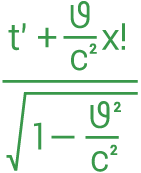
Theoretical Physics
The studies conducted at BLTP are interdisciplinary; they are directly integrated into international projects with the participation of scientists from major research centres in the world and are closely coordinated with the JINR experimental programmes. Intensive development of the research is planned in nuclear and particle astrophysics, Higgs boson phenomenology, hadron physics under extreme conditions (in connection with the experimental programme of the NICA/MPD project, and experiments at RHIC, LHC and FAIR), lattice QCD calculations. Studies in condensed matter physics will be more tightly correlated with practical problems in the field of nanotechnology for creation of new materials and electronic devices.
- Quantum field theory and particle physics
- Nuclear theory
- Theory of condensed matter
- Modern mathematical physics
- Research and education project DIAS-TH

Information Technologies
Development of the computing infrastructure
The aim of the further development of the JINR computing infrastructure is to provide performance of a whole range of competitive research activities at the world’s level at JINR and cooperating centres worldwide both within the JINR programme for scientific research and development, in particular the NICA megaproject, and within the priority research tasks that are performed in cooperation with leading research centres such as CERN, FAIR, BNL, etc.
For the Laboratory of Information Technology, one of the major objectives in the Seven-year plan is the creation of a unified information environment integrating a number of various technological solutions, concepts and techniques. Such environment should integrate supercomputer (heterogeneous), grid- and cloud-complexes and systems in order to grant optimal approaches for solving various types of scientific and applied tasks. The necessary requirements to such an environment are scalability, interoperability, and adaptability to new technical solutions.
Mathematical support of studies conducted at JINR
The solution of problems in computational physics and mathematics, encompassing a wide spectrum of research underway at JINR, requires the development of new mathematical methods and approaches, the creation of algorithms and software for numerical and symbolic-numerical simulations with the help of the newest computer hardware with multi-core architecture, coprocessors and graphic accelerators. Such computational systems provide the way towards significant speed-up of mathematical calculations by selecting the paralleling technology which takes into account the specificity of the problem under solution. The adaptation to the heterogeneous architectures of previously developed software and the creation of new applications based on modern parallelization techniques making the best use of the opportunities provided by the available computing resources are of particular importance. A separate task is the development of software platforms and environments for designing parallel applications and development of services that will significantly simplify the user work on such computing complexes.

Education
Being an international research organization, JINR has a great potential for education and training in the disciplines coinciding with the Institute’s main directions of research. While providing a formal education, like that of a university, is not a purpose of the Institute, graduate and postgraduate students from the Member States can join the various research groups of JINR Laboratories to be trained in physics, engineering, computer science and other fields. It is the responsibility of the University Centre of JINR to ensure the effective use of JINR’s facilities and expertise for education of highly qualified research scientists and engineers from the Member States. To implement this mission, UC shall pursue the following activities in the next seven years.
- The first priority of UC remains the delivery of a high-quality service to the students from the Member States, who arrive at JINR Laboratories to prepare their BSc, MSc and PhD theses.
- An important task of UC is to organize educational summer activities for undergraduate students.
- An emerging activity of UC is the practical training in nuclear physics and accelerator technology for students and young scientists from the Member States.
- The outreach programmes of JINR aimed at school children and teachers from the Member States is an important part of the activity of the University Centre.
- Besides teaching and supervision of graduate and postgraduate students, UC is responsible for the academic and technical training of JINR personnel.
- Since 2016, UC has been running the funds intended for the Association of Young Scientists and Specialists of JINR (AYSS)

Development of the Engineering Infrastructure
The engineering infrastructure of JINR includes a supply system of energy resources like electricity, heat, cold and hot water, liquid nitrogen; cooling and sewage systems, communication and telecommunication systems and safety system.
- Supply of energy resources;
- Communication and telecommunication means;
- Safety.

Innovation Activities
The strategic goal of the innovative development of JINR for the period up to 2030 is to make the Institute the leading center for the transfer of knowledge of the JINR member countries in the field of nuclear physics and accelerators. Implementation of innovation plans for the period 2021–2023 assumes concentration of efforts in the following main directions. Technology transfer and commercialization.
- Establishment of an international innovation center for nuclear physics research
- Effective integration into the global innovation system
- Information support and PR for innovation activities at JINR

Monitoring the implementation of seven-year plan and long-term development strategy of JINR
Strategic Plan for the Long-Term Development of JINR for the period up to 2030 and beyond, presented in November 2020, defines the principles for the formation of the next medium-term plans for the development of JINR. The JINR Strategy formulates a system of performance indicators for the Institute and provides for its application for monitoring its activities. The system of indicators and monitoring are a key tool for analyzing the progress of solving the tasks formulated in the current seven-year development plan and assessing the effectiveness of JINR’s work in key areas of activity, and ensuring the compliance of the scientific, scientific, educational and innovative activities of the Institute with the most modern international standards, and its demand by the JINR Member States.
Monitoring of the main indicators is provided by the indicators of the lower level, a detailed system of characteristics, parameters and indicators, approved upon adoption of the next seven-year plan for the development of JINR and adjusted on an annual basis. The system of indicators and monitoring will be applied starting from 2022.

Human Resources and Social Policy
The Seven-year plan of the development of JINR for 2017–2023 is aimed at providing effective organization of work of the Institute’s personnel, improvement of the system of assessment and remuneration of labour of the scientific researchers and other categories of the JINR staff, attraction of young scientific, engineering, and administrative personnel, and social protection of the staff. The Plan includes the following activities:
- Human resources;
- Efficiency of work, improvement of the management system;
- Salary, social policy;
- Young Staff at JINR.

Financial Support
The revenues of the JINR Financial Plan are formed mainly from the contributions of the Member States. The increase in the estimated amount of contributions for 2022 and 2023 is 2.5% annually. The income also includes the payment of arrears of Member States in the payment of contributions, in accordance with the approved schedules, and the collection of other income.